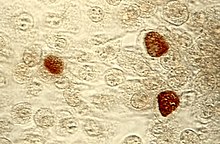Chlamydia trachomatis
| Chlamydia trachomatis | |
|---|---|
 |
|
| Chlamydia trachomatis in brown | |
| Scientific classification | |
| Domain: | Bacteria |
| Phylum: | Chlamydiae |
| Class: | Chlamydiae |
| Order: | Chlamydiales |
| Family: | Chlamydiaceae |
| Genus: | Chlamydia |
| Species: | C. trachomatis |
| Binomial name | |
|
Chlamydia trachomatis (Busacca 1935) Rake 1957 emend. Everett et al. 1999 |
|
| Synonyms | |
|
|
Chlamydia trachomatis (/kləˌmɪdiə/ /trəˈkoʊmətᵻs/), commonly known as chlamydia, is one of four bacterial species in the genus Chlamydia.Chlamydia is a genus of pathogenic bacteria that are obligate intracellular parasites. C. trachomatis is a Gram-negative bacterium. It is ovoid in shape and nonmotile. The bacteria are nonspore-forming, but the elementary bodies act like spores when released into the host. The inclusion bodies of C. trachomatis were first described in 1907 by Stanislaus von Prowazek and Ludwig Halberstädter during research on trachoma. C. trachomatis agent was first cultured in the yolk sacs of eggs by Professor Tang Fei-fan, et al. in 1957.
Disorders caused by C. trachomatis include chlamydia, trachoma, lymphogranuloma venereum, nongonococcal urethritis, cervicitis, salpingitis, pelvic inflammatory disease, and pneumonia.
...
Wikipedia
